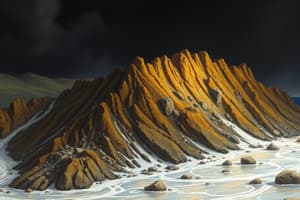Podcast
Questions and Answers
When considering mass wasting, which of the following factors is most influential in the downslope movement of weathered particles?
When considering mass wasting, which of the following factors is most influential in the downslope movement of weathered particles?
- Water
- Gravity (correct)
- Oversteepened slopes
- Removal of vegetation
- Earthquakes
Which of the following responses are examples of how water can promote mass wasting? (Choose all that apply)
Which of the following responses are examples of how water can promote mass wasting? (Choose all that apply)
- Water can saturate sediment, reducing the integrity of the slope and allowing it to move. (correct)
- Waves and streams can undercut banks and cliffs, causing them to fail. (correct)
- Water can infiltrate sediment, partially filling the pore spaces between grains and reducing slope cohesion. (correct)
- When water is added to weathered particles, the mass of the sediment is increased, which can cause slope instability. (correct)
- Water enhances the ability of vegetation to grow on weathered particles, promoting mass wasting.
When dry sediment accumulates, the angle of repose represents what property of the deposit?
When dry sediment accumulates, the angle of repose represents what property of the deposit?
- The steepest angle at which those sediments can accumulate and remain stable. (correct)
- The angle of repose is the angle at which sediment accumulates when slopes move very slowly.
- The angle of repose represents cross-bedding in the sediment.
- The angle of repose represents the angle the sediment maintains when undercut by waves and streams.
- The angle of repose is the angle at which sediment accumulates when slopes move very quickly.
When sediment accumulates, the angle of repose can be increased by changing which of the following conditions?
When sediment accumulates, the angle of repose can be increased by changing which of the following conditions?
Define mass wasting.
Define mass wasting.
A __________ is formed when vertical incision by a stream is the primary process, with relatively minimal mass wasting.
A __________ is formed when vertical incision by a stream is the primary process, with relatively minimal mass wasting.
Which of the following correctly states the role of rivers and mass wasting in the formation of the Grand Canyon?
Which of the following correctly states the role of rivers and mass wasting in the formation of the Grand Canyon?
Over time, mass wasting causes __________.
Over time, mass wasting causes __________.
What rock type is the easiest for a river to cut through?
What rock type is the easiest for a river to cut through?
Which of the following are classifications describing how rock and other material move downslope?
Which of the following are classifications describing how rock and other material move downslope?
What is mass movement?
What is mass movement?
How is a fall different from creep?
How is a fall different from creep?
How are slumps and slides related?
How are slumps and slides related?
Flashcards are hidden until you start studying
Study Notes
Mass Wasting Overview
- Mass wasting refers to the downslope movement of sediment and rock due to gravity.
- Key factors influencing mass wasting include gravity, water, vegetation removal, earthquakes, and oversteepened slopes.
Water's Role in Mass Wasting
- Water can saturate sediment, weakening slope integrity and facilitating movement.
- Infiltration reduces cohesion by filling pore spaces between grains.
- Increased mass of wet sediment may lead to slope instability.
- Water supports vegetation growth, indirectly promoting mass wasting.
- Undercutting by waves and streams can destabilize banks and cliffs.
Angle of Repose
- Represents the steepest angle at which sediment remains stable without sliding.
- Conditions affecting the angle of repose include moisture content; slight water addition can increase stability, while excessive moisture may reduce it.
- Drying out sediment does not enhance stability.
Mass Wasting Classification
- Types of mass wasting movement include fall, slide, slump, creep, and flow.
- A fall occurs rapidly in steep areas, while creep occurs slowly in gentler slopes.
Mass Wasting and Geological Features
- Vertical incision by a stream leads to the formation of slot canyons.
- Rivers, through erosion, shape features like the Grand Canyon, aided by associated mass-wasting processes that transport material.
- Over time, mass wasting leads to the widening of canyons.
Rock Types and Erosion
- Shale is the rock type that rivers cut through most easily compared to conglomerate, limestone, sandstone, and cemented siltstone.
Understanding Mass Movement
- Mass movement is exclusively driven by gravity, regardless of the presence of other factors.
- Slumps are related to slides as they both involve the rapid movement of material down slopes, but the mechanics of each process differ.
Studying That Suits You
Use AI to generate personalized quizzes and flashcards to suit your learning preferences.




